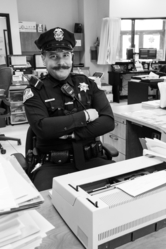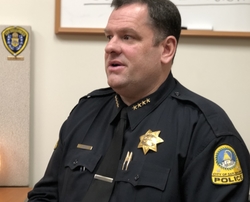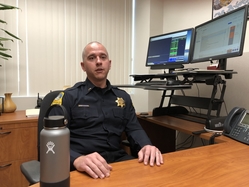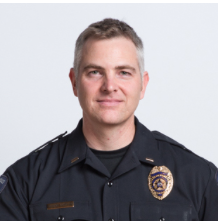When Officer John Hampton of the San Bruno Police Department in San Bruno, CA, first heard that mindfulness training was being offered to him and his fellow cops, he had two reactions.

“I think my major reaction was: ‘Oh, there’s some hippy thing that they’re trying to get cops to do,’” he said. “When I say that, it’s funny because that’s not my voice. It’s the caricature of a police officer-like voice. In the back of my mind, I was interested and open to it, but that police voice was saying: ‘What a waste of time!’”
Hampton’s initial response was not unique. As former San Bruno Chief of Police Ed Barberini put it when he first broached the subject of mindfulness training with his officers and other staff in 2018, “I got a lot of interesting looks.”
Nevertheless, at Barberini’s direction, Hampton and 77 other employees — including police officers, dispatchers, clerks, management analysts, and community service officers — agreed to participate in the Mindful Badge Initiative. The program, developed by former police officer Lieutenant Richard Goerling, provided two and a half days of immersive mindfulness training that covered the biological and psychological responses to trauma, the cumulative effect of trauma, and how it can impact job performance. The participants also learned how to meditate and a number of other mindfulness techniques to help manage responses to traumatic events.
Barberini’s motivation for offering the program was simply to help police officers weather

the day-to day challenges of doing police work. “We take people from a young age, we throw them into an environment where they go from one negative call to the next, and in my mind, I just see how it piles up. It may not take one significant incident to really impact somebody; it just can be a combination of things,” said Barberini, who recently left San Bruno after five years to become chief of police in San Mateo.
Barberini told the police force that the overall purpose was to have them walk away from the training with skills that work in their relationships on the job and at home. “This was an opportunity to provide them a service to being a better husband, spouse, wife, friend, whatever it is, to make you stronger in those areas,” which he said resonated with them.
The program came about indirectly, from an experience that Lieutenant Ryan Johansen had when he was a new police officer in San Diego about 17 years ago.

“I got into an officer-involved shooting where a suspect that had just minutes before shot a detective, put about 14 rounds into my car while I was sitting in it. I could do nothing besides lay there and hope that none of them hit me, which fortunately they did not. And then what ensued was a very long vehicle pursuit that culminated in an officer-involved shooting in which the subject’s life was taken by a number of us responding to what he was doing to us. It was just a difficult thing to process for a young cop.”
Afterward, Johansen was on his way to have drinks with his fellow officers, but his field training officer, who had heard about the shooting, showed up and told Johansen, “’No, you're not going with those guys,’” said Johansen. “’We're going somewhere else.’ He was not a mindfulness practitioner. But he had a lot of military experience, combat experience. And I think he knew that this could make or break me at this point, how I responded to it. All he did was take me out and say, ‘Look, we're going to develop coping mechanisms because you are going to have to cope with this over the years, not over hours or days. But we're going to develop healthy coping mechanisms. And it's not going to be having beers with the boys.’”
Johansen took that encounter to heart, which led to his own investigation and use of mindfulness practices.
Fast forward to 2018. After telling Barberini about the Mindful Badge Initiative, Johansen reached out to Goerling to see if it would be a good fit for the San Bruno Police Department. “I knew that he was having some success with this [program] up north [in Oregon], and that he had done it enough to experience the challenges of bringing an idea like this into a little bit of a walled-off audience like you get in law enforcement.”

What makes the program palatable to police, said Goerling, is how he approaches the conversation about trauma. “It's not about being broken and getting fixed. It's about ‘Oh, yeah, I’m trauma injured and that comes with the territory of being a first responder, of being a police officer’.”
And the Mindful Badge program, according to Goerling, is focused on resilience and offers ways of coping. “I want [police officers] to see themselves as moving through the arc of their career where they experience trauma, and they have a greater locus of control around the choices they make to seek recovery and healing.” Besides San Bruno Police Department, Goerling has trained other San Francisco Bay Area police forces in the Mindful Badge Initiative, including the Emeryville Police Department and the Palo Alto Police Department.
In a 2017 TedXTalk about the Mindful Badge Initiative, Goerling said: “Mindfulness police culture changes the way we show up on a radio call. It allows us to meet our community in their suffering, and in their crisis without bringing our own unregulated emotion, which is often a source of cognitive failure.”
And Goerling stresses that he is only interested in working with police forces where there's clear interest in changing the culture. "When I’ve talked to leaders part of my conversation to a police leader is what are you trying to achieve? Do you want to make a city leader happy? Or do you want to shift the culture? If it’s the former I’m not interested."
“We did all kinds of different exercises — body scans, heart-centered meditation, gratitude meditations, or simple tasks like being silent, focusing on what we were eating, or questioning how do you feel when you go from one room to the next, sensations on skin, etc.,” recalled Hampton about the training.
He said that like any new thing before it’s been practiced, at first it was hard to understand. But Hampton said the program intrigued him enough to learn more by joining meditation groups outside of work. He also has been using a neurofeedback app called MUSE that uses EEG to help catalogue to what extent meditation puts him in a calm zone.
“While you’re meditating, it plays back nature sounds. The way it works, the more your mind is racing and not calm, the more you hear thunderstorm sounds, high winds and heavy rains. And the more you’re able to calm your mind, the more you hear a calm breeze with birds chirping,” he said.
Barberini has put some things from the training into a daily practice. “I'll be honest with you. I do a body scan every night before I go to sleep. I used to have a hard time going to sleep and I would wake up every night at like 3:30 in the morning, and I had a hard time going back to sleep. Now I have no problem going to sleep. If I do wake up, I can I can get myself back to where I need to be and I sleep much better.”
He also said that he meditates about 10 to 15 minutes each day. “When I get in the car to come to work after I've done [ meditation] and I know that I have some tough stuff going on out here. Or I'm dealing with some tough stuff from the day before. I'm in a way better place than I was a half hour earlier [before meditating].”
For most of the police officers who went through the training, Johansen said, they’re using simple techniques, including body scans, five-second breathing exercises to help ground them, and being aware of sensations in the body. “Especially talking practically, like as you're responding to a really serious call. They're learning that the feeling I have in my head where things are starting to tunnel in on me and my limbs are tingling — that's adrenaline in my body. And I've learned that I can police that. I don't just have to let it happen. And then just by reconnecting to a couple of cleansing breaths, or by focusing on breathing through my nose, instead of my mouth, I can calm all those reactions and get back to a place where I can make good decisions about the things I'm doing.’”
Hampton has seen how the mindfulness practice has impacted his life overall. “I’m able to steer away from quick judgements more often, and look at my life from a macro perspective rather than letting day-to-day small problems or gripes or issues control the narrative in my brain.”
A small study of a mindfulness-based resiliency program, which is foundational to the Mindful Badge program, showed a reduction in the levels of the stress hormone cortisol, and self-reported reductions in stress, anger, burn out, sleep disturbances and reactivity among a small group of 31 police officers who went through eight weeks of training. That was compared to 30 police officers who did not receive the training, according to a paper written by Goerling and Michael S. Christopher, among others, and published in 2018 in the journal Psychiatry. Three months following the end of the training, there was no difference between the two groups on those measures. Researchers suggested “booster sessions” might extend the positive effects of the training.
Goerling describes one of the lessons learned from the study: “What is clear is that when skills are not practiced, the outcomes diminish.”
Sustainability is also important to the San Bruno Police Department, said Johansen. As such, Johansen, Hampton and two other police officers are now working with Mindful Badge over three months to learn how to serve as peer coaches to their fellow police officers.
But even from the get-go, Johansen believes that one of the reasons that fellow officers agreed to do the training was the support by the police chief, and that Johansen has been an inside source for modeling practices encouraged in the Mindful Badge program. “[Other cops] can walk by and see that I'm sitting here for an hour with my eyes closed like I'm practicing these things, because I know it makes me a better human, and they can also look at me and say: ‘That guy has been one hell of a cop. I wouldn't mind being the cop that he's been.’ So, I'm not just this softy, meditation-kind-of-weird guy. I'm a weird guy — don't get me wrong, but I'm a good cop, too.”
Although they don’t have hard data on changes that are directly attributable to the Mindful Badge program, Barberini reports some anecdotal improvements, such as police officers saying they’re sleeping better and many fewer police officers off on workers compensation-related injuries.
“We only have 49 sworn police officers,” said Barberini. “I will tell you that before this, it was pretty regularly we would have five or six [officers] who were out on some type of injury. Sometimes it's due to fatigue, sometimes people just being burnt out. Now, maybe we'll have one at any given time.”
And while trauma was a word that was never discussed, “that’s no longer the case,” he said. “I just think it's part of the normal conversation, and it never was before. Before you would never admit to anything like that.”





Comments (0)